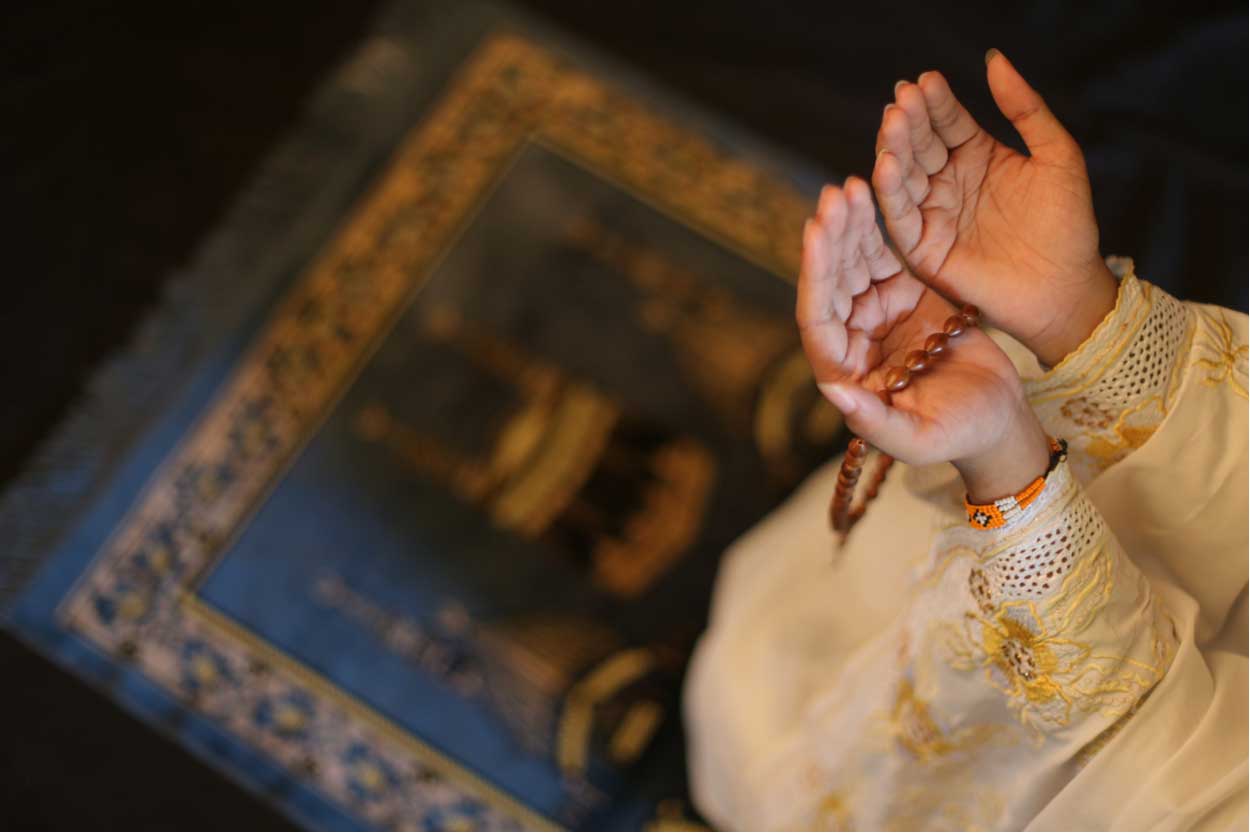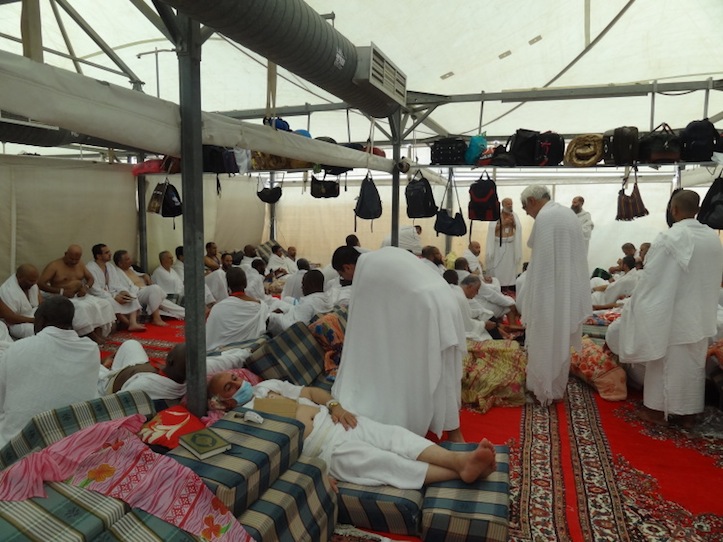Responding to Allah
Talbiyah is an integral part of everything ihram stands for, perfectly complementing it. Linguistically, it means “answering (after hearing)”, “agreeing” and “accepting”. In the Hajj context, it is an extension of the intention (niyyah). Thus, while the latter is uttered quietly and privately, the former is chanted, preferably, openly and loudly.
Talbiyah is an invocation for drawing ever closer to, and for an eventual union with, the beloved Creator. It is an affirmation of one’s tawhidic faith and of one’s readiness to sacrifice of his possessions and self for the sake of the Creator’s ordinances. A pilgrim finds himself and feels the impact of Allah’s announcement in the following Qur’anic verse:
“And (due) to Allah from the people is a pilgrimage to the House – for whoever is able to find thereto a way. But whoever disbelieves – then indeed, Allah is free from need of the worlds” (Alu ‘Imran, 3:97).
Talbiyah, moreover, is answering the call of Allah – the Owner of the House (Ka’bah) and the Host of Hajj. Ibrahim had been summoned to proclaim to humanity the ritual and convention of Hajj. A pilgrim desires to be of those whose hearts yearn towards the Makkah and its holy mosque as well as Hajj, and of those who have been foretold that they will hasten to the caller (Ibrahim) and his call. They will do so from each and every corner of the globe and will be using all available means of transport.
Which further means that he who turns a deaf ear – and a blind heart – to this call is lifeless and his senses debilitated. Consequently, talbiyah features references to God’s blessings upon people and their expected gratitude for them.
A pilgrim is quick in recognizing and thanking God for everything, but especially for the blessing of all blessings, which is the truth of Islam. As he indirectly rejects the lifelessness and blindness of non-belief by asserting that there is no good, nor excellence (i.e. there is no life worth living, and no paradigm worth subscribing to), except that which is in God’s Hands.
Secrets of Talbiyah
Exuberant, a pilgrim wishes to be included into the coverage of those heavenly declarations of the truth and to be an instrument of their realization. He does not want to be left behind in any way. Those declarations are comprehended by the heart, pronounced by the tongue, and translated into the vicissitudes of the real world by limbs. And these three: the heart, the tongue and limbs, make up a believer’s axis which connects him with the rest of worthy material and immaterial alignments. That talbiyah is encouraged to be recited openly, loudly and basically everywhere, proves its external and collective dimensions.
According to Abu Hamid al-Ghazzali, “as for the state of sanctification (ihram) and the talbiyah from the miqat (onward), let the pilgrim know that this has the sense of answering the call of God Most High. Therefore, have the hope that you will be accepted, as well as the fear that you will be told: “You are neither accepted (in my service, i.e. your talbiyah is not honoured) nor blessed”, so that you will waver between hope and fear, and be stripped of your might and power, thereby becoming completely dependent on the Grace and Generosity of God Most High. For the time of talbiya is the real beginning of the matter and the place of the danger.
Sufyan bin ‘Uyayna said: “Ali bin al-Husayn – may God be pleased with them – once performed the Pilgrimage. When he had entered the state of sanctification and was well mounted on his camel, his colour became pallid; then he trembled and a shiver befell him to the extent that he could not recite the talbiya. When it was said to him: “Why are you not reciting the talbiya?” He said: “I fear that it will be said to me: “You are neither accepted nor blessed.” And when he later recited the talbiya he fainted and fell off his camel. This continued to happen to him until he completed his pilgrimage.”[8]
The Accepted Hajj
Having responded to the universal call, for a pilgrim things become personal afterwards. In a sea of pilgrims, he – when all is said and done – is on his own. The central aspect of Hajj sets in. Other aspects, though important, are supplementary, playing second fiddle to the former. A pilgrim is committed to his own personal case as a part of an extensive grid. He is not sure and worries if his response to the call is accepted or not, in keeping with a maxim that it is easy to love or care, but hard to be loved and cared about, in that reciprocity is the answer. As an anomaly on earth and in heaven, one way relationships never worked, and never will.
A pilgrim is thus expected to work on going from strength to strength during Hajj, and through recurring life challenges after that, to make sure that his response has been heard, that he has been welcomed to the spiritual festival hosted by the Creator, and that his Hajj efforts have been appreciated – and accepted. Sure enough, one of the indicators that a person’s Hajj has been accepted is that after Hajj he feels positive changes in his life overall, in his attitude, manners and relationships. The same is to be felt by others. A victorious pilgrim does not talk his Hajj; he walks (lives) it.
When a pilgrim sees multitudes of people on Hajj, he relates the phenomenon to the humble beginnings of the place. He perceives God’s answers to Ibrahim’s prayers intended for that place, and the fruits of Prophet Muhammad’s work as a grand finale. He is so happy to be linked with such historical developments which dictated the course of human history, with holy prophets being main protagonists.
It is confirmed that all prophets performed the pilgrimage. A pilgrim’s repetitive and loud talbiyah is a mark of excitement and appreciation to be part of the best company that graced the world. As if the voices of talbiyah tend to transcend the barriers of time and space and reach out to those illustrious personalities and their legacies. As if the voices, additionally, are directed to reverberate horizontally throughout the world, and vertically throughout the universe, in order to be heard by all creation and be attested to. A pilgrim “sees’ those prophets and their victories. He personally bears witness to them. As one would expect, Hajj spells the convincing evidence of those victories.
Stories from Hajj
For instance, it was narrated that Abdullah Ibn ‘Abbas said:
“We were with the Messenger of Allah between Makkah and Madinah, and we passed through a valley. He said: ‘What valley is this?’ They said: ‘Azraq Valley.’ He said: ‘It is as if I can see Prophet Musa putting his fingers in his ears and raising his voice to Allah reciting talbiyah, passing through this valley.’ Then we travelled on until we came to a narrow pass, and he said: ‘What pass is this?’ They said: ‘Thaniyyat Harsha’ or ‘Laft.’ He said: ‘It is as if I can see Prophet Yunus, on a red she-camel, wearing a woollen cloak and holding the reins of his she-camel, woven from palm fibres, passing through this valley, reciting talbiyah.”[9]
Talbiya is an intimate communication between a pilgrim and his Creator and Master. A pilgrim refers to himself as “I”, the singular first-person pronoun, and to God as “You”, the second-person pronoun. This means that there should be nothing standing between a person and God in his prayers, yet in the rest of the communication modes and the whole life. Hurdles of all sorts are to be promptly recognized and conquered. Regardless of how much each pilgrim succeeds in actualizing this admittedly profound proviso, it nevertheless ought to be the goal not just of Hajj, but also of other spiritual endeavours of a person.
As a result, Hajj is not as much about “coming” and “being”, as it is about “becoming”. The words of talbiya: “Here I am, O You (Allah), here I am…” – together with the implication of ihram – represent the starting point and the first phase of the transformation.
Muhammad Asad often touched on this transformational sentiment, weaving it subtly through a variety of topics and subtopics. For example, at one point he drew attention to the condition of a ship that transported the Egyptian and North-African pilgrims across the Red Sea to the port-city of Jeddah, the gateway to Makkah, and in which Muhammad Asad also was a passenger for his first Hajj.
He said that the condition was terrible, bordering on inhumane, because the shipping company, greedy for the profits of the short Hajj season, had literally filled the ship to the brim without caring for the safety, comfort and amenities of the passengers.
However, the pilgrims did not care. In great humility, with only the goal of the voyage before their eyes, they bore uncomplainingly all that unnecessary hardship. They were immune, as it were, to the suffering and were ecstatic.
Muhammad Asad added:
“Whoever saw this had to recognize the power of faith which was in these pilgrims. For they did not really seem to feel their suffering, so consumed were they with the thought of Makkah. They spoke only of their Hajj,and the emotion with which they looked toward the near future made their faces shine. The women often sang in chorus songs about the Holy City (Makkah), and again and again came the refrain (of talbiyah): ‘Labbayk, Allahumma, Labbayk!’ (“Here I am, O Allah, here I am)”.[10]
(To be continued…)
[1] Muhammad Nasiruddin al-Albani, Rites of Hajj and ‘Umrah from the Qur’an, Sunnah and Narrations from the Pious Predecessors, www.islamhouse.com, 2010, accessed on January 31, 2022.
[2] Ibn Majah, Sunan Ibn Majah, Book 25, Hadith No. 7.
[3] Al-Bukhari, Sahih al-Bukhari, Book 27, Hadith No. 15. Al-Tirmidhi, Jami’ al-Tirmidhi, Book 9, Hadith No. 3.
[4] Ibn Majah, Sunan Ibn Majah, Book 36, Hadith No. 3932.
[5] Al-Bukhari, Sahih al-Bukhari, Book 78, Hadith No. 73.
[6] Muhammad Asad, The Road to Makkah, (New Delhi: Islamic Book Service, 2004), p. 363.
[7] Malcolm X and Alex Haley, The Autobiography of Malcolm X, (New York: Ballantine Books, 1992), pp. 396, 390-391
[8] Abu Hamid al-Ghazzali, The Book on the Secrets of Pilgrimage, http://ghazali.org/books/hajj-text.htm, accessed on January 30, 2022.
[9] Ibn Majah, Sunan Ibn Majah, Book 25, Hadith No. 10.
[10] Muhammad Asad, The Road to Makkah, p. 357.
Part 1 – The Spirituality of Hajj: An Introduction
Pages: 1 2 3


